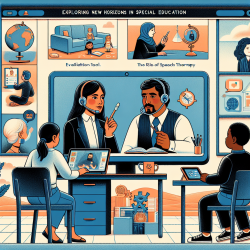Embracing Change: The Future of Special Education with Telehealth
In the ever-evolving landscape of special education, the need for innovative solutions has never been more pressing. As a Special Education Director, you're no stranger to the challenges that come with ensuring legal compliance, providing leadership, and addressing therapist staffing shortages. But what if there was a way to streamline these processes while enhancing the quality of education for students with special needs?
Enter telehealth—a revolutionary approach that's transforming the way we deliver speech therapy evaluations and other critical services. In this blog, we'll explore how telehealth is reshaping special education and why it's a change worth considering.
The Power of Telehealth in Special Education
Telehealth is more than just a buzzword; it's a practical solution that offers numerous benefits for school districts, therapists, and students alike. Here are a few reasons why telehealth is gaining traction in the field of special education:
- Accessibility: Telehealth breaks down geographical barriers, allowing students in remote or underserved areas to access high-quality therapy services.
- Flexibility: Online therapy sessions can be scheduled at convenient times, reducing the need for students to miss valuable classroom instruction.
- Cost-Effectiveness: By eliminating travel expenses and reducing the need for physical infrastructure, telehealth can be a more budget-friendly option for school districts.
- Consistency: With telehealth, students can receive regular therapy sessions, ensuring consistent progress and improved outcomes.
Telehealth and Speech Therapy Evaluations
One of the most significant areas where telehealth is making an impact is in speech therapy evaluations. Conducting these evaluations online allows for a more flexible and efficient process, benefiting both students and therapists. Here's how:
- Comprehensive Assessments: Online platforms enable therapists to conduct thorough evaluations using a variety of digital tools and resources.
- Immediate Feedback: Real-time interactions allow therapists to provide instant feedback and make necessary adjustments to therapy plans.
- Data-Driven Decisions: Digital platforms facilitate the collection and analysis of data, helping therapists make informed decisions about a student's progress and needs.
Leading the Way with Telehealth
As a leader in special education, embracing telehealth is an opportunity to drive meaningful change within your district. By integrating telehealth services, you can address therapist staffing shortages, ensure legal compliance, and ultimately enhance the educational experience for students with special needs.
Networking with other professionals, attending conferences, and participating in webinars can provide valuable insights into the latest telehealth trends and best practices. By staying informed and proactive, you can position your district as a leader in innovative special education solutions.
Conclusion
The future of special education is bright with the integration of telehealth services. By embracing this change, you can improve accessibility, flexibility, and consistency for students while addressing the challenges of therapist staffing shortages and legal compliance. The time to explore telehealth is now—are you ready to lead the way?










